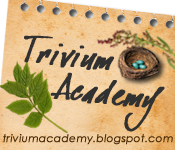I've been thinking about what we'll be using next year in 4th grade for science lately and I've been tremendously blessed as all the options that I'm considering are in someway or another on their way to me. A generous fellow homeschooler has allowed me to preview her copy of The Elements: Ingredients of the Universe by Ellen McHenry, I purchased a used copy of God's Design for Chemistry: Properties of Atoms and Molecules for less than half the retail price and I have a few books coming from the library via interlibrary loan so I can have all the options side by side and make a decision about our 4th grade studies.
A friend recently asked me about studying biomes, which is what we'll be doing in 5th grade and as I was providing her links and resources it dawned on me that I didn't know what we were going to do! Before I put that thought off thinking it's too soon to develop a plan for 5th-8th studies, I realized that what we do in 5th and up will determine how I need to approach our studies in 4th and even now in 3rd. I don't want 5th grade to be *BAM*, now you're in 5th grade you need to start doing this and that. I want 4th grade to be the bridge between what we're doing now and what we will be doing. A perfect example is science vocabulary, if I expect Camille to write out 5-10 words and their definitions a week in 5th, I want to start her out with 2-3 words a week now in 3rd or 4th.
I looked at all the major curricula available on the homeschool market. I gave everything a chance and I could not find something that covered animals in a way that would be challenging to us that would hold our interest for an entire year and still allow us to read living books or provide enough hands-on, learning through doing type of approach. I decided that I'd make our own and build all the major different habitats in whatever ways we could. I found the book Habitats by Pamela Hickman at www.christianbook.com for $2.99 and decided that would be our real life application. The only thing left to do was to find a spine to use for the nonfiction information. I also decided that I needed to find a new spine for Danny since when Camille is in 5th, he'll be in 1st and we'll being doing our science together.
The author warns that this book was not written to be fully integrated with any other subject area or any specific grade level.
Each chapter of the book addresses a major phylum of animal and presents information about :
-phylum's classification
-diversity and distribution (anatomical characteristics and habitats)
-collection of specimens
-maintenance of specimens
-health and safety issues concerning the specimens
-Teaching Strategies which include:
Observation: Observe and investigate the structure, movement, feeding, behavior/response and reproduction/growth of the specimenHolley says that "although some factual background is necessary, try to maximize thinking and minimize memorizing. Let process lead to content when possible. For example, allowing students to first work with live animal (process) and then discussing specific facts about the animal (content) will make the facts more understandable and relevant because students will have seen the animal live, up close, and in action."
a. Under behavior and response, students will explore geotaxis, thermotaxis, galvanotaxis, phototaxis, magnetotaxis, hydrotaxis, thigmotaxis, chemotaxis, rheotaxis
Ecology: investigating the habitat and surroundings of the animal and discover its place in nature.
Integration: Activities to integrate what the student has learned with writing, fine arts, social studies (history and geography), and societal/environmental issues. Math skills are also used when possible including constructing and analyzing data tables and graphes, measuring, calculating, and problem solving.
Chapter questions, activities and challenges are designed to be used in hands-on experiences in which students are actively involved in scientific investigation. When possible, they follow an inquiry-oriented approach designed to develop the following science process skills:
1.Observing
2. Measuring/Graphing: learn to make, record, and display quantitative information
3. Comparing/Contrasting: will learn to identify distinguishing characteristics among objects or events.
4. Sequencing: will learn to put events in order
5. Prediction: will learn how to propose possible outcomes
6. Experimentation: will learn how to design experiments to test their predictions
7. Analyzing/Reasoning: will learn how to explain the meaning and importance of data gathered or facts given.
8. Drawing Conclusions: will learn to make general statements about particulars.
9. Modeling: will learn to construct physical or mental models.
10. Communication: will develop skills for conveying information in oral, written, or pictorial form.
A sample chapter, condensed.
Section One: Lower Invertebrates
2. Sponges
I. Classification is presented as Kingdom, Subkingdom, Phylum, and Classes
II. Diversity and distribution
III. General Phylum Characteristics
IV. Specific Class Characteristics
a. Class CalcareaV. Importance of Sponges
b. Class Sclerospongiae
c. Class Demonspongiae
d. Class Hexactinellia
VI. Collection of Species
VII. Maintenance of Species
VIII. Health and Safety (Teachers, Students, Sponges)
IX. Teaching Activities
X. Habitat
a. Sponge Habitat
b. Sponge Habitat Comparisons
c. Land Sponges
d. Different Forms for Different Folks
e. Walk a Mile in My Shoes: Have students try to put themselves in the sponge's place by having them react orally or in written form to the following questions:
__1. Would you rather be a marine sponge or a freshwater sponge? Why? (Acceptable answer given.)
__2. Would you rather be a sponge with long spicules or one with short spicules? (Acceptable answer given.)
f. Muddy Water=No Sponges
g. Sponge Structure
h. Sponge Size Comparisons
i. Sponge- One or Many?
j. Green Sponges?
k. Sponge Regeneration
l. Sponges Come Together
XI. Feeding
a. Sponge Food
b. How Do Sponges Get Food?
c. Fabulous Filter
d. Is It Food Yet?
e. Attack of the Hungry Encrusters
XII. Reproduction and Development
a. Sponge Reproduction
b. Smoking Sponges
c. Gemmules- Why and Why Not
d. Observe Gemmules
XIII. Integration with other Subject Areas
a. Writing: report in which they explain which sample was the natural sponge and which was synthetic.IXX. Release of Specimen.
b. Fine Arts: Have students paint a picture of a sponge using a natural sponge, or, write a song or poem entitled "I'm Just a Lowly Sponge."
c. Social Studies:
__1. History: Why did it take so long to discover that sponges are animals? (Possible answers provided)
__2. Geography: Where are sponges harvested today? In the past?
d. Societal/Environmental Issues:
__1. Have students respond either orally or in written form to the question, How can studying reaggregation behavior of dissociated sponge cells be useful to humans? (Answer provided.)
__2. Why can sponges be thought of as biological apartment houses (or shopping malls)?
We're not planning on maintaining a sponge specimen at home but this can be overcome by providing videos and I will be tapping into a few of our local resources like the University's aquarium for help. If we can collect a specimen, it will probably be successful due to the help of professionals. Hopefully I will gain a few professional advisors when I complete a Master Naturalist course next Spring through a local college.
Other likely specimens we will be exploring at home are: Planaria (after discussing it with Carolina Biological Supply), Earthworms, Land or Aquatic Snails, Spiders, Crayfish, Sowbugs or Pillbugs, Ants, Butterfly or Moth, Crickets, Mealworm Beetles, Goldfish or Guppies, Toad or Frog, Green Anole, Tortoise (already have one), Zebra Finches (not recommended in book but we already have them), Rodent (hamster, mice, gerbils). Um, the rodent one is the only one that will have to be carefully considered. Smile.
For supplies, of course we'll need habitats to house the critters for observation. It is my plan to only use animals that can be released back to the wild or in the rodent department, back to its original owner. A compound microscope is needed as well unless the activities involving one are skipped. There are so many components to this curriculum that I don't feel as if I've even scratched the surface of the treasures it holds!
I am ecstatic about using Animals Alive! for our 5th grade year, I think it will be an experience that the kids will remember for a long time. Check out Animals Alive! by Dennis Holley from your library or you can purchase a copy at Amazon or Barnes and Noble online.





























6 comments:
Jessica,
Queen Homeschool has some great books you could use for this or in addition to . . . Pet's in a Jar & The Nature Study Idea Book. Their Nature Journal is awesome for little guys. Animal studies are so fun!
Hi, Jessica.
Janice-VanCleave:Science-Around-World
is another great Habitat or Biome experiment book. You can check it out at Amazon. We are using this with MFW ECC this year which includes Environmental Science.
Hope you find everything that you need to complete your studies. :)
Excellent idea Kysha! I forgot about that book, it would be an excellent resource for biomes, I'll have to see about using it with Danny!
A plan is forming...
:) Jessica
My plan for fourth grade which did not materialize, for my older son (now in sixth grade) was that we were to study HABITATS one by one. Within each habitat we would learn not just animals but some birds and some plants the weather and earth science stuff, and some cultural stuff if applicable.
For example, study the rain forest. Where is it, is it all over the world and is it within USA or is it mostly in one place? What is it, what lives there, the plants and animals and insects and birds (some of course not all), and then weather/climate, earth science (like are there mountains there, river, or what etc.) and a little culture of the people (is the place turned into cities or what indiginous people live there now or has it been settled etc). Also similar stuff for 'the arctic'.
Other ideas not so tied to one region are: swamp, river, brook, forest, ocean, etc.
My plan was to use all living books and just basically do a ton of reading, again using all good exciting books.
I had always wished we would lapbook but my kids still resist it. Sigh.
Some days I think I really was cut out to be the mom of a little girl who I imagine would love lapbooking and reading horse stories and fairy tales...
Thanks for the detailed review! I'm using Singapore this year for my 3rd grader...you've given me some great ideas for 4th & 5th!
Lee
Are they too young for the Draw Write now books about habitat?
It does seem like the year is going by so fast and next year's curriculum choices had better be underway soon. Thanks for the heads up.
Post a Comment